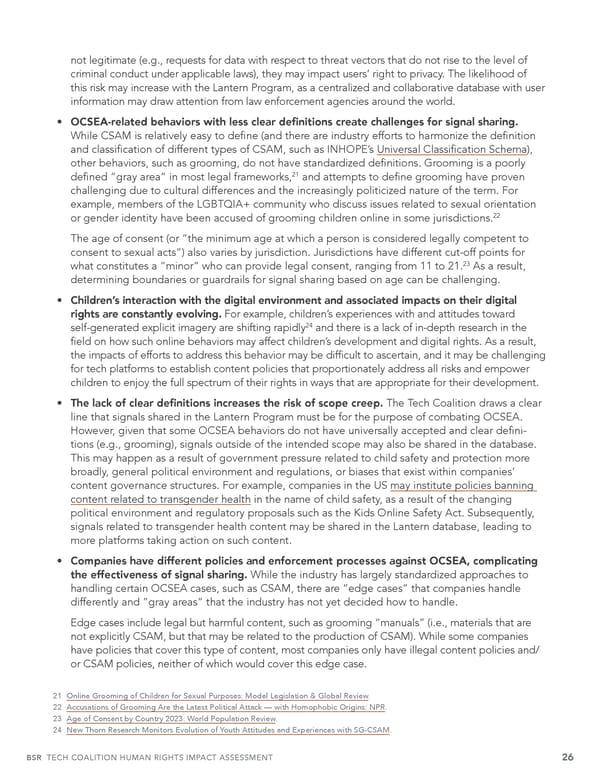not legitimate (e.g., requests for data with respect to threat vectors that do not rise to the level of criminal conduct under applicable laws), they may impact users’ right to privacy. The likelihood of this risk may increase with the Lantern Program, as a centralized and collaborative database with user information may draw attention from law enforcement agencies around the world. • OCSEA-related behaviors with less clear de昀椀nitions create challenges for signal sharing. While CSAM is relatively easy to de昀椀ne (and there are industry efforts to harmonize the de昀椀nition and classi昀椀cation of different types of CSAM, such as INHOPE’s Universal Classi昀椀cation Schema), other behaviors, such as grooming, do not have standardized de昀椀nitions. Grooming is a poorly 21 and attempts to de昀椀ne grooming have proven de昀椀ned “gray area” in most legal frameworks, challenging due to cultural differences and the increasingly politicized nature of the term. For example, members of the LGBTQIA+ community who discuss issues related to sexual orientation 22 or gender identity have been accused of grooming children online in some jurisdictions. The age of consent (or “the minimum age at which a person is considered legally competent to consent to sexual acts”) also varies by jurisdiction. Jurisdictions have different cut-off points for 23 As a result, what constitutes a “minor” who can provide legal consent, ranging from 11 to 21. determining boundaries or guardrails for signal sharing based on age can be challenging. • Children’s interaction with the digital environment and associated impacts on their digital rights are constantly evolving. For example, children’s experiences with and attitudes toward 24 and there is a lack of in-depth research in the self-generated explicit imagery are shifting rapidly 昀椀eld on how such online behaviors may affect children’s development and digital rights. As a result, the impacts of efforts to address this behavior may be dif昀椀cult to ascertain, and it may be challenging for tech platforms to establish content policies that proportionately address all risks and empower children to enjoy the full spectrum of their rights in ways that are appropriate for their development. • The lack of clear de昀椀nitions increases the risk of scope creep. The Tech Coalition draws a clear line that signals shared in the Lantern Program must be for the purpose of combating OCSEA. However, given that some OCSEA behaviors do not have universally accepted and clear de昀椀ni- tions (e.g., grooming), signals outside of the intended scope may also be shared in the database. This may happen as a result of government pressure related to child safety and protection more broadly, general political environment and regulations, or biases that exist within companies’ content governance structures. For example, companies in the US may institute policies banning content related to transgender health in the name of child safety, as a result of the changing political environment and regulatory proposals such as the Kids Online Safety Act. Subsequently, signals related to transgender health content may be shared in the Lantern database, leading to more platforms taking action on such content. • Companies have different policies and enforcement processes against OCSEA, complicating the effectiveness of signal sharing. While the industry has largely standardized approaches to handling certain OCSEA cases, such as CSAM, there are “edge cases” that companies handle differently and “gray areas” that the industry has not yet decided how to handle. Edge cases include legal but harmful content, such as grooming “manuals” (i.e., materials that are not explicitly CSAM, but that may be related to the production of CSAM). While some companies have policies that cover this type of content, most companies only have illegal content policies and/ or CSAM policies, neither of which would cover this edge case. 21 Online Grooming of Children for Sexual Purposes: Model Legislation & Global Review. 22 Accusations of Grooming Are the Latest Political Attack — with Homophobic Origins: NPR. 23 Age of Consent by Country 2023: World Population Review. 24 New Thorn Research Monitors Evolution of Youth Attitudes and Experiences with SG-CSAM. BSR TECH COALITION HUMAN RIGHTS IMPACT ASSESSMENT 26
 Tech Coalition Human Rights Impact Assessment of the Lantern Program Page 25 Page 27
Tech Coalition Human Rights Impact Assessment of the Lantern Program Page 25 Page 27